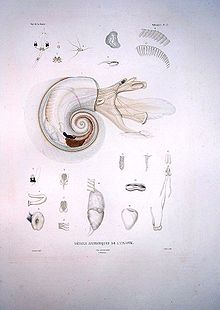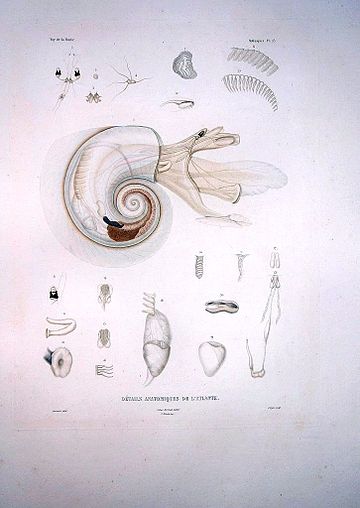海蝶螺屬(學名:Atlanta),又叫明螺屬,是玉黍螺目海蝶螺科之下一個全浮游(holoplanktonic)海洋腹足綱軟體動物的屬,也是海蝶螺科的模式屬[3]。
此條目目前正依照其他維基百科上的內容進行翻譯。 (2018年4月28日) |
分佈
除Atlanta californiensis外,全部19種都生活在熱帶和亞熱帶水域。大多數物種(十種)是世界性的,其餘的9種物種中,有5種在印度太平洋,有2種只限於太平洋,1種在印度-大西洋,1種只限於大西洋。
它們是在熱帶和亞熱帶海洋中漂浮或游泳的蝸牛。大多數都具有全球性的分布,但是A. brunnea,A. pulchella和A. quoyi僅在美國水域中發現。 A. fusca、A. pacifica和A. rosea只生活在日本周圍的海洋中。
描述
It has been recognized by several authors that identification of species in this genus is difficult and is dependent on their morphology of eyes, radula and operculum.
Main diagnostic features include: the shell and keel are calcareous;[4] larval shell becomes the spire in the adult shell.[4]
Snails of this genus are very small. Their coiled, calcareous[4] shell has a diameter of less than 1 cm. The protoconch of the larval shell is retained after metamorphosis and becomes the spire of the adult shell.[4] The number of spire whirls varies from 2½ (in the A. lesueuri- group) to 6 (A. gibbosa) and is thus also helpful in the identification of a species. The spire shape differs between the species groups, from very small (A. lesueuri- group), to inflated or flat (A. inflata- group ) to large (A.inclinata- group and A. gibbosa- group).
They can retract into their shell and close it off with an operculum. This operculum is cartilaginous and flexible. In 1961 Richter distinguished three types of the operculum[5] in which the larval gyre of the operculum is apical. This gyre can be relatively somewhat larger (macro-oligogyre), smaller (micro-oligogyre) or a single gyre (monogyre).
The eye morphology also consists of three types with differences in pigmented region between the lens and the retina.
The radula is typically taenioglossate with one central (rachidian) tooth, with on each side one lateral tooth and two marginal teeth. In 13 species the number of tooth rows increases during growth (Type I), while in 8 species the radula has a limited number of tooth rows (Type II).[5]
Many authors (e.g., Thiriot-Quiévreux, 1973, p. 240; Richter, 1974, p. 60; Seapy, 1990, p. 107) admit that identification of Atlanta species is difficult and including soft-part features (eyes, radula, operculum) or application of transmitted light to observe inner shell structures (Richter, 1987, p. 178) are very helpful in distinguishing species with similar shells.[1] However, such methods are unavailable for fossil material.[1] This makes identifying fossil species of Atlanta quite difficult and even well-preserved specimens occasionally can only be related to existing taxa with a query (e.g., Atlanta sp. in Janssen, 2004, p. 108; Atlanta cf. echinogyra in Jansen 2007).[1] Advantageous in this study of fossil atlantids, however, is the fact that all specimens are preserved as opaque aragonitic shells as a result of recrystallisation, which facilitates assessing protoconch shape and ornament with a normal 25 or 50× binocular magnification, they are thus much easier studied than in the usually very transparent and shiny Recent specimens.[1] Still, here, too, study of the larval shell shape and micro-ornamentation by SEM is highly desirable or even indispensable.[1]
物種
Atlanta includes a large number of Recent species. Lalli & Gilmer (1989)[6] listed 14 species, but Richter & Seapy (1999)[7] recognised 21 extant species, provisionally subdivided into seven 『species groups』 (and one species unassigned).[1] A further Recent species was described since; Atlanta selvagensis de Vera & Seapy, 2006.[1]
截至2018年4月15日[update],WoRMS紀錄本屬物種如下:
- Atlanta ariejansseni Wall-Palmer, Burridge & Peijnenburg, 2016
- Atlanta brunnea J.E. Gray, 1850
- Atlanta californiensis Seapy & Richter, 1993
- Atlanta echinogyra Richter, 1972
- Atlanta fragilis Richter, 1993
- Atlanta frontieri Richter, 1993
- Atlanta gaudichaudi Gray, 1850
- Atlanta gibbosa Souleyet, 1852
- Atlanta helicinoidea J.E. Gray, 1850
- Atlanta inclinata J.E. Gray, 1850
- Atlanta inflata J.E. Gray, 1850
- Atlanta lesueurii J.E. Gray, 1850
- Atlanta meteori Richter, 1972
- Atlanta oligogyra Tesch, 1906
- Atlanta peronii Lesueur, 1817
- Atlanta plana Richter, 1972
- Atlanta rosea Gray, 1850
- Atlanta selvagensis de Vera & Seapy, 2006
- Atlanta tokiokai van der Spoel & Troost, 1972
- Atlanta turriculata d'Orbigny, 1836
- Species Atlanta peresi Frontier, 1966
- Species Atlanta pulchella A. E. Verrill, 1884
- 異名
- Subgenus Atlanta (Heliconoides) d'Orbigny, 1836 接受為 Heliconoides d'Orbigny, 1836 (original rank)
- Atlanta affinis Tesch, 1906 接受為 Atlanta inclinata J.E. Gray, 1850
- Atlanta bivonae Mandralisca, 1840 接受為 Oxygyrus inflatus Benson, 1835 (異名)
- Atlanta bulimoides d'Orbigny, 1834 接受為 Limacina bulimoides (d'Orbigny, 1834) (original combination)
- Atlanta cordiformis Gabb, 1873 接受為 Atlanta selvagensis de Vera & Seapy, 2006 (doubtful synonym)
- Atlanta costae Mandralisca, 1840 接受為 Atlanta peronii Lesueur, 1817 (異名)
- Atlanta depressa Souleyet, 1852 接受為 Atlanta helicinoidea J.E. Gray, 1850
- Atlanta depressa Gray, 1850 接受為 Atlanta helicinoidea J.E. Gray, 1850 (doubtful synonym)
- Atlanta fossilis Tate, 1898 † 接受為 Leptonotis fossilis (Tate, 1898) †
- Atlanta fusca Souleyet, 1852 接受為 Atlanta brunnea J.E. Gray, 1850
- Atlanta gaudichaudii Souleyet, 1852 接受為 Atlanta gaudichaudi Gray, 1850
- Atlanta helicinoides Souleyet, 1852 接受為 Atlanta helicinoidea J.E. Gray, 1850
- Atlanta inclinata Souleyet, 1852 接受為 Atlanta inclinata J.E. Gray, 1850
- Atlanta inflata Souleyet, 1852 接受為 Atlanta inflata J.E. Gray, 1850
- Atlanta inflata d'Orbigny, 1835 接受為 Heliconoides inflatus (d'Orbigny, 1835) (original combination)
- Atlanta keraudrenii Lesueur, 1817 接受為 Atlanta peronii Lesueur, 1817
- Atlanta lamanoni Gray, 1850 接受為 Protatlanta souleyeti (E. A. Smith, 1888) (Invalid: secondary junior homonym of Steira lamanoni Eschscholtz, 1825)
- Atlanta lamanonii Souleyet, 1852 接受為 Protatlanta souleyeti (E. A. Smith, 1888) (異名)
- Atlanta lesueurii Souleyet, 1852 接受為 Atlanta lesueurii J.E. Gray, 1850
- Atlanta lesueurii d'Orbigny, 1835 接受為 Limacina lesueurii (d'Orbigny, 1835) (original combination)
- Atlanta macrocarinata Bonnevie, 1920 接受為 Atlanta inclinata J.E. Gray, 1850
- Atlanta megalope Richter, 1961 接受為 Atlanta inclinata J.E. Gray, 1850
- Atlanta pacifica Tokioka, 1955 接受為 Atlanta gaudichaudi Gray, 1850
- Atlanta primitia Smith E.A., 1888 接受為 Atlanta lesueurii J.E. Gray, 1850 (dubious synonym)
- Atlanta quoyana Souleyet, 1852 接受為 Atlanta inflata J.E. Gray, 1850
- Atlanta quoyii J.E. Gray, 1850 接受為 Atlanta inflata J.E. Gray, 1850
- Atlanta rangi d'Orbigny, 1836 接受為 Oxygyrus inflatus Benson, 1835 (synonym)
- Atlanta rangii d'Orbigny, 1834 接受為 Limacina rangii (d'Orbigny, 1834) (original combination)
- Atlanta reticulata d'Orbigny, 1834 接受為 Peracle reticulata (d'Orbigny, 1834) (original combination)
- Atlanta rosea Souleyet, 1852 接受為 Atlanta rosea Gray, 1850
- Atlanta sculpta (Issel, 1911) 接受為 Protatlanta sculpta Issel, 1911
- Atlanta souleyeti E. A. Smith, 1888 接受為 Protatlanta souleyeti (E. A. Smith, 1888) (original combination)
- Atlanta steindachneri Oberwimmer, 1898 接受為 Atlanta peronii Lesueur, 1817 (synonym)
- Atlanta trochiformis d'Orbigny, 1834 接受為 Limacina trochiformis (d'Orbigny, 1834) (original combination)
Based on similar morphologies, these species have been placed in seven species groups:[4][8]
| Atlanta (19 recent species) |
| ||||||||||||||||||||||||||||||||||||||||||||||||||||||||||||||||||||||||||||||
Tesch (1908) was the first to group together the species of Atlanta sharing similar morphologies.[4] He recognized four species groups; the Atlanta peronii-, Atlanta inflata-, Atlanta turriculata-, and Atlanta inclinata-groups.[4] In addition to these four, three additional ones are currently recognized; the Atlanta lesueurii-, Atlanta gaudichaudi- and Atlanta gibbosa groups.[4] Except for Tesch's Atlanta turriculata-group, the composition of Tesch's species groups has changed by species invalidations, the addition of new species over time, and addition of three new species groups.[4] The main changes in Tesch's species groups have occurred in the Atlanta peronii-group (with Atlanta gaudichaudi and Atlanta lesueurii now forming their own species groups) and the Atlanta inclinata-group (the Atlanta gibbosa now forming its own group).[4]
參考文獻
外部連結
Wikiwand in your browser!
Seamless Wikipedia browsing. On steroids.
Every time you click a link to Wikipedia, Wiktionary or Wikiquote in your browser's search results, it will show the modern Wikiwand interface.
Wikiwand extension is a five stars, simple, with minimum permission required to keep your browsing private, safe and transparent.

